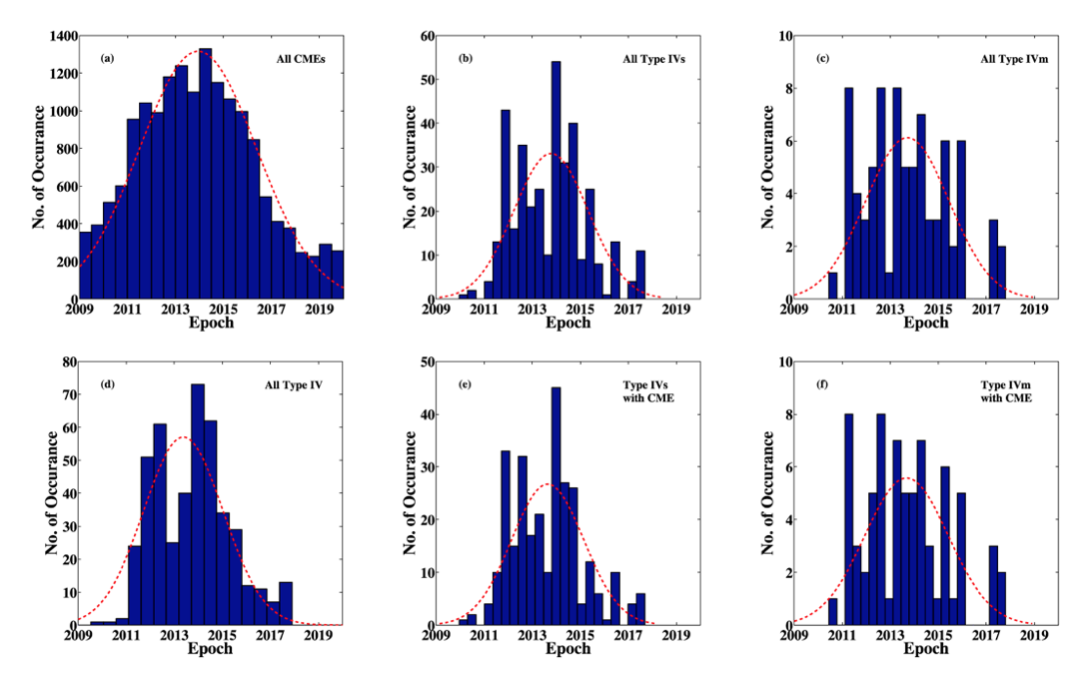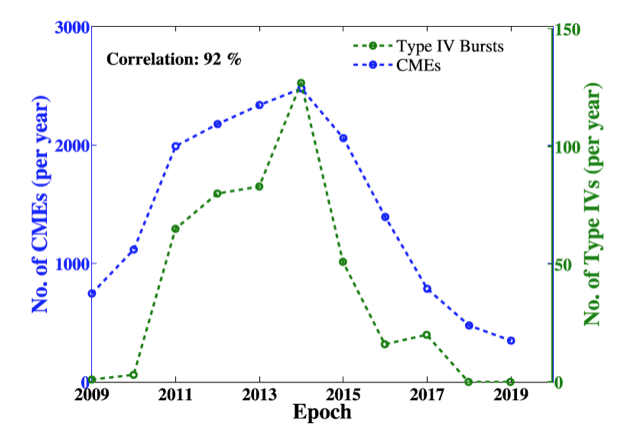Coronal mass ejections are large eruptions of magnetized plasma from the Sun (Webb et. al. 2012) that are often accompanied by radio emission, generated by the energetic electrons produced during these eruptions (Gopalswamy et. al. 2004). These electrons can generate radio emission in the corona through various emission mechanisms (Melrose, 1980). The most common radio bursts associated with CMEs are type II and type IV bursts. CMEs are often accompanied by broadband continuum emission at decimetric and metric wavelengths which are known as type IV radio bursts (Pick, 1986), that can have either stationary or moving sources and various emission mechanisms (Bastian et. al. 1998). The association of CMEs with type IV bursts is also poorly understood. We perform a statistical study on the association of type IV radio bursts to CMEs in solar cycle 24.
Observations and Data Analysis
We use CMEs detected with the Large Angle and Spectrometric Coronagraph (LASCO) onboard the Solar and Heliospheric Observatory (SOHO) and the Cor1 and Cor2 coronagraphs from the Sun-Earth Connection Coronal and Heliospheric Investigation (SECCHI) onboard the Solar Terrestrial Relationship Observatory (STEREO). The radio bursts are provided by the event lists from the Space Weather Prediction Center, which catalogues radio events since the year 1996.
 Figure 1 – Left panel: Solar radio dynamic spectra of a moving type IV burst on October 18, 2017. The duration of the burst is $\sim 7 $ minutes and it shows a frequency drift of $\sim 0.09$ MHz/s from 160 MHz to 60 MHz. Right panel: Solar radio dynamic spectra of a stationary type IV burst on October 03, 2011. The duration of the burst is $\sim 7 $ hours.
Figure 1 – Left panel: Solar radio dynamic spectra of a moving type IV burst on October 18, 2017. The duration of the burst is $\sim 7 $ minutes and it shows a frequency drift of $\sim 0.09$ MHz/s from 160 MHz to 60 MHz. Right panel: Solar radio dynamic spectra of a stationary type IV burst on October 03, 2011. The duration of the burst is $\sim 7 $ hours.
We divided the type IV bursts into moving type IV bursts (IVm) and stationary type IV bursts (IVs) based on their spectral characteristics (drift rates and duration). For the stationary/moving type IV bursts classification, in addition to the drift rate, we also considered the duration of the moving type IV bursts as mentioned by Robinson (1978) and Gergely (1986). To study the association of type IV bursts with CMEs, we used the temporal criteria: a CME should appear in LASCO-c2 coronagraph FOV within $\approx 2 $ hours of the start time of the type IV burst. In the case that these criteria were not enough to determine a CME association within SOHO/LASCO-c2 and STEREO-cor2, the STEREO-cor1/cor2 coronagraph data was investigated manually.
Results and Conclusions
There were total 16107 CMEs reported with SOHO/LASCO and additional 5944 with STEREO-A and B combined. There was total 446 type IV bursts in this solar cycle. We categorized all CMEs based on their linear speeds and angular widths as ‘Fast’, ‘Slow’, ‘Wide’ and ‘Narrow’ CMEs. CMEs with linear speed $\geq 500$ km/s are classified as ‘Fast’ CMEs, with the remaining classified as ‘Slow’. Similarly the CMEs with angular width $\geq 60^{\circ}$ are classified as ‘Wide’ CMEs, with the remaining classified as ‘Narrow’ CMEs.
 Figure 2 – The distribution of CMEs and type IV bursts in the solar cycle 24. Histogram for: (a) all CMEs; (b) all type IVs bursts; (c) all type IVm bursts; (d) all type IV bursts; (e) all type IVs bursts with CMEs; (f) all type IVm bursts with CMEs.
Figure 2 – The distribution of CMEs and type IV bursts in the solar cycle 24. Histogram for: (a) all CMEs; (b) all type IVs bursts; (c) all type IVm bursts; (d) all type IV bursts; (e) all type IVs bursts with CMEs; (f) all type IVm bursts with CMEs.
Out of 80 type IVm bursts observed, 73 ($\sim 91 \%$) were accompanied by white-light CMEs. However, only $\sim 0.5\%$ of the total CMEs in this solar cycle were accompanied by type IVm bursts. $\sim62\%$ were associated with ‘Fast’ CMEs and $\sim38\%$ were associated with ‘Slow’ CMEs, unlike type II radio bursts where the majority are associated with ‘Fast’ CMEs (Kahler et. al. 2019). Out of 366 type IVs bursts, 286 bursts ($\sim78 \%$) were accompanied with white-light CMEs. Only $\sim1.8\%$ of the total CMEs in this solar cycle were accompanied with type IVs bursts. Type IVs bursts are almost equally associated with ‘Fast’ and ‘Slow’ CMEs, with $\sim 46\%$ and $\sim 54\%$, respectively, and also have quite similar associations with ‘Wide’ and ‘Narrow’ CMEs, with $\sim 59\%$ and $\sim 41\%$, respectively. Most of the type IVm bursts ($\sim85 \%$) had duration of a few minutes. Contrary to this, the duration of type IVs varies from a few minutes to a few hours. Our analysis shows that $\sim 95 \%$ of type IVm bursts had drift rates $\leq 0.5$ MHz/s. The correlation between the occurrence of these CMEs and type IV bursts is $\sim 92 \%$, which indicates that the occurrence of type IV bursts closely follows the occurrence of CMEs. Thus, we conclude that a CME eruption may be necessary for the generation of type IV emission as opposed to non-eruptive flares.
In this work, we present the first comprehensive long-term statistical study of type IV radio bursts during solar cycle 24, where we find a significant correlation between the occurrence of type IV radio bursts and CMEs, with $\sim$81\% of the observed bursts being accompanied by CMEs, based on a temporal association with white-light CME observations. However, we found that only $\sim 2.2 \%$ of the CMEs are accompanied by type IV radio bursts. We categorized the type IV bursts as moving or stationary based on their spectral characteristics and found that only $\sim 18 \%$ of the total type IV bursts in this study were moving type IV bursts. Our study suggests that type IV bursts can occur with both ‘Fast’ ($\geq 500$ km/s) and ‘Slow’ ($< 500$ km/s), and also both ‘Wide’ ($\geq 60^{\circ}$) and ‘Narrow’ ($< 60^{\circ}$) CMEs. However, the moving type IV bursts in our study were mostly associated with ‘Fast’ and ‘Wide’ CMEs ($\sim 52 \%$), similar to type II radio bursts. Contrary to type II bursts, stationary type IV bursts have a more uniform association with all CME types. This study also provides the typical duration of type IV bursts and drift rates of moving type IV bursts.
 Figure 3 – The number of CMEs (per year) and type IV bursts (per year) from 2009-2019. The number of type IV bursts are very less as compared to the number of CMEs however, there is a very strong correlation ($92 \%$) between the occurrence of the white-light feature and radio emission.
Figure 3 – The number of CMEs (per year) and type IV bursts (per year) from 2009-2019. The number of type IV bursts are very less as compared to the number of CMEs however, there is a very strong correlation ($92 \%$) between the occurrence of the white-light feature and radio emission.
Based on the recent paper: Kumari, Anshu, et. al. 2021 ApJ 906, 79: On the occurrence of type IV solar radio bursts in the solar cycle 24 and their association with coronal mass ejections. The Astrophysical Journal, DOI: https://doi.org/10.3847/1538-4357/abc878.
Additional info: Homepage: https://researchportal.helsinki.fi/en/persons/anshu-singh Acknowledgement: A.K. acknowledges the ERC under the European Union’s Horizon 2020 Research and Innovation Programme Project SolMAG 724391.
References
Gergely, T. E. (1986). Solar Physics, 104, 175.
Kahler, S. W., Ling, A. G. and Gopalswamy, N. (2019). Solar Physics, 294, 134.
Robinson, R. D. (1978). Solar Physics, 60, 383.
*Full list of Authors: Anshu Kumari, Diana E. Morosan, Emilia K. J. Kilpua
